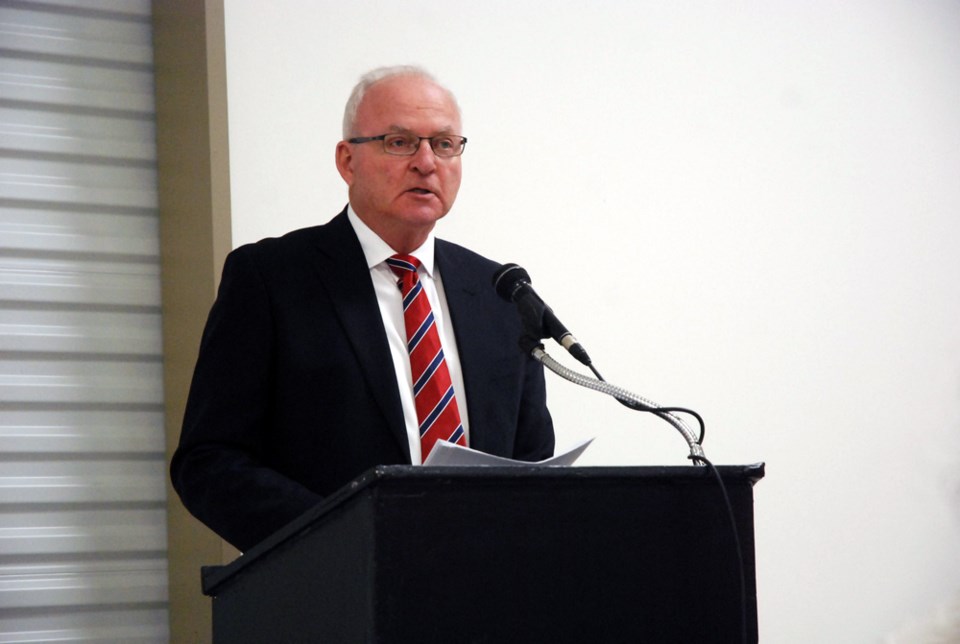Agricultural Minister Lyle Stewart visited Humboldt on Monday for the Humboldt & District Chamber of Commerce’s most recent business luncheon at the Uniplex. The minister talked about agriculture related issues, most notably the state of the industry considering the ongoing grain transportation issue and low livestock numbers.
“The province has submitted recommendations to the Canada Transportation Act for review to fix the problems we encountered so that we do not encounter the same issues year after year,” said Stewart during his talk. “If accepted, these recommendations will result in a transportation system with a capacity and flexibility to accommodate Saskatchewan’s future economic growth in every sector.”
Stewart talked about the agriculture industry’s recent growth despite the downturn in oil as well as the strengths and goals the industry is focusing on. For example, the province’s plan for growth includes increasing crop production by 10 million tonnes, increasing agricultural exports to $15 billion annually, increasing revenue from value-added sectors to $6 billion annually, and establishing Saskatchewan as an international leader in bioscience by the year 2020. As such, Stewart said establishing a reliable and efficient transportation system to accommodate this growth will be a priority.
In the meantime, declining oil prices have also had a good and bad effect on the industry. On the one hand, while the low oil prices may negatively impact the economy, it does offer a reprieve for those in the agriculture industry in terms of crop pricing.
“Dropping oil prices are not good for the economy of Saskatchewan, there’s no question about that, but the Canadian dollar is the petrodollar so when oil prices drop, the dollar drops and that makes our agricultural exports more competitive, so that’s a little bit of a tradeoff there,” said Stewart. “There is an upside for the agriculture industry temporarily when oil prices drop, but it’s difficult for the economy.”
Aside from the economic aspect of the industry, Stewart also mentioned the protection policies the government has been trying to put in place for livestock producers. The Western Livestock Price Insurance Program, for example, offers protection for producers in the case of unexpected drops in livestock prices and it’s entirely industry funded. This would be of particular help considering the recent drop in livestock numbers, which was brought up by one of the listeners during the subsequent question and answer period.
“The gentleman asked about cattle numbers being down and they are. Not dramatically over the last year or two, but they’re down over the last period of time since BSE in 2003,” said Stewart. “It takes time for the cattle industry to rebound. You can’t just order up a new calf crop that’s bigger than the one before; you have to increase your breeding herd and you have to have the grassland and hay to support that herd, so it takes a little time to turn that ship around, but I’m confident it will happen.”
Stewart also explained how those numbers pertain to the grazing rate how those numbers relate to the grazing rate. As the cattle prices increase, so too will the grazing rate, something he said the government doesn’t “monkey around with” in any way.
“On government grazing leases, there’s a formula basically based on cattle prices, so during the years after BSE when cattle rates were dropping, the grazing rates were dropping and then remained low until the last couple years, when they started to increase,” he said. “We saw a dramatic increase in cattle prices in 2014 and so the grazing lease rates followed that. So they are up 74 per cent this year, but that’s also in keeping with the formula that lowered them previously.”
Lastly, Stewart further stressed the importance of bringing more young people into the industry and the awareness efforts they’ve undertaken to promote those goals.
“Now the industry is populated with young people. We’ve had less than one full year of strong cattle prices, so obviously the industry hasn’t had a chance to react to that yet,” said Stewart. “It takes time, particularly to build a herd. But I think over the next year or two, we’ll start to see those numbers turn around, and when they do, I believe they’ll turn around dramatically.”




